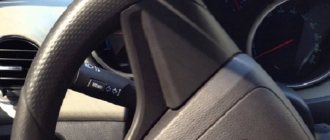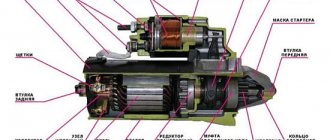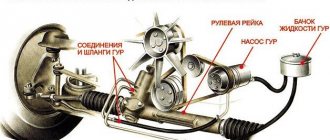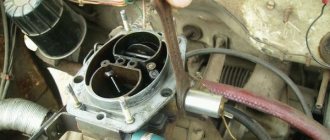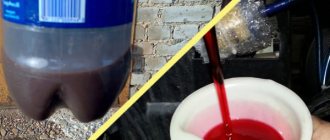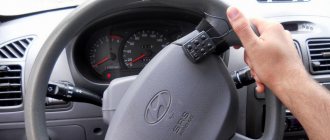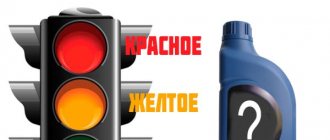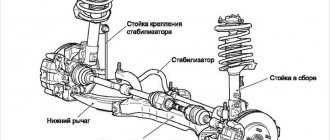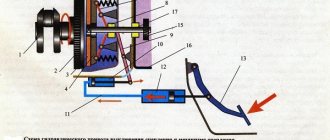Many drivers are familiar with the situation: when driving in a straight line, the car goes quietly, but when you turn, “singing” begins. There are many options for answering where the noise is coming from, so before making repairs you need to make sure that the source is identified correctly. Correct diagnostics will eliminate the need to spend money on replacing a unit that could still serve. Let's try to figure out which bearing is humming when turning, and what could be making noise besides it.
Use Suprotek lubricant
Suprotek Universal PRO grease for bearings, gears, CV joints
To increase the service life and restore worn rolling bearings, gears, CV joints and other components that use grease.
more reviews
Feedback about use:
Valentin, Yeysk
Hyundai Santa Fe
I have been using Suprotek restoration lubricant for several years, maintaining the front ball joints. At the moment, everything in the car is original. All reviews >>
Systematizing the symptoms
To understand the causes of extraneous noises, you need to systematize the symptoms of their occurrence. This will significantly narrow the search range and help you quickly determine which bearing is humming when turning. You need to find a place where you can safely make several maneuvers: a deserted section of the road or a flat asphalt area.
Listen to the car in different modes: acceleration, braking, driving in a circle in both directions with acceleration and at a calm pace. Note in which modes extraneous noise appears, intensifies and disappears. You can write down all your sensations in a notebook so you can analyze them later. Just don't write on the go.
Power steering noise when the car is warm
After heating to operating temperature, especially overheating under intense loads, the viscosity of the working fluid decreases. High-quality oils resist this much better; counterfeit products and inadequate replacements with approximate analogues immediately become apparent.
Most often, a hum when warmed up indicates that the pump parts have begun to wear out. More viscous oil is better at preventing noise. In this state, the pump can operate for quite a long time, until a critical change in the geometry of the parts occurs.
The pump begins to work more and more unevenly, and low-frequency vibrations appear on the steering wheel. An increase in engine speed, by definition, affects the performance of the pump, therefore, in the initial stages, the appearance of defects may disappear or decrease.
Wear in the actuators will also affect the sound. The pump has to experience a greater load than when working on fully serviceable valves and hydraulic cylinders, this will also manifest itself acoustically. An additional symptom will be an increase in steering effort, all other things being equal.
When the shock absorber is faulty
Sometimes the cause of the noise is the creaking of the support bearing when turning the steering wheel. If creaking and howling noises occur no matter which way you turn, check the shock absorbers. Often the problem is in the bearings of this unit. It may be enough to remove any dirt that has clogged up under the boot. How to diagnose? Read on.
Try turning the steering wheel while standing still. Even better, ask an assistant to “steer”, while you listen and watch the movement of the shock absorber spring into the gap between the upper edge of the tire and the wing arch. If the part turns jerkily, as if something is interfering with it, it means that the support bearing creaks when turning the steering wheel. It's simple. There is no movement - neither the transmission nor the hubs can make noise - the shafts and wheels do not rotate. In this case, the only thing to suspect is the shock absorber struts.
Reasons for noisy operation of the hydraulic booster
If the power steering howls, then the reason may not be directly related to the breakdown of any of its components. For example, it can produce loud noise, especially when turning the steering wheel, due to the presence of air bubbles in the working fluid. The reasons may be the following:
- The engine ran for some time without the power steering reservoir cap.
- The integrity of the unit circuit is compromised.
- There are microscopic cracks in hoses and pipes, sometimes not even leaking, which makes them much more difficult to detect.
- Foreign impurities have entered the power steering oil or the fluid itself has been incorrectly selected, which is why stable foam is created when the fluid is pumped through the pump.
Remember that whenever foaming of the power steering fluid is detected, the cause of this phenomenon should be immediately eliminated.
If the hub is not in order
It happens that the bearing hums when turning right, but otherwise everything is fine. On a straight road the car moves silently. When turning left, no noise is heard either; sometimes it may even seem that in this driving mode the sound background in the cabin improves.
In the same way, it may be that the bearing hums when turning left, but is silent when moving straight ahead. Similar to the previous case, when turning right, no extraneous noise is heard, and sometimes it seems that it is even more comfortable to move this way than in a straight line. What is the reason for this strange behavior?
If the hum only occurs when turning, there is about a 90% chance that the problem is in the wheel bearing. In advanced cases, the hub “sings” even with a straight trajectory. When driving faster than 100 km/h, the sound may disappear, but when the speed decreases to 80 km/h, it appears again.
Noise when turning the steering wheel
The sound when the steering wheel moves in different directions can be of two types:
- normal - characterized by the operation of the hydraulic booster. This does not indicate any malfunctions, the power steering simply has this feature;
- talking about problems. If the hum becomes stronger with each movement of the steering wheel and does not stop, this may indicate a malfunction of the power steering.
For self-diagnosis, you should look under the hood and check:
- The fluid level in the power steering system, if it becomes lower, top it up.
- Possibility of leaks, if after topping up after a short period of time the liquid becomes less again, look for the leak.
- Other common problems may be: a malfunction of the power steering pump, belt, or air getting into the system. In all these cases, examination by a specialist is required.
Which bearing hums when turning right and which bearing when turning left?
Did you carefully write down all the results of the race in a notepad (or on a piece of paper)? This data can greatly facilitate diagnosis. If you know exactly which bearing hums when turning left and which when turning right, you can narrow down your search.
Let's find out further...
When asked which bearing hums when turning right, any car mechanic will confidently answer that it is the left one. When asked about a hum when turning left, the answer will be the same confident: “the problem is in the right bearing.” Why is that?
When the car begins to turn, the force of inertia tries to keep it on its previous trajectory. The mass tends to the outer arc of the turn, the car rolls. The load falls on the wheels located on the outer side, the bearing operates in extreme mode and begins to make noise.
| Action of centrifugal force | |
| When driving in a turn, a centrifugal force acts on the car, which is directed towards the outer curve of the road (from the center - to the outer edge of the turn). The magnitude of the centrifugal force is proportional to the square of the speed: when the speed of movement doubles, the centrifugal force increases four times, etc. Therefore, even a slight reduction in speed before a turn will improve safety during the turn. Braking must end before entering the turn. |
We figured out which bearing hums when turning left, and which when maneuvering in the opposite direction, and why. The sound can be caused by any problem. Clip depletion or problems with the separator are the most common causes of failure.
It seems that it has become clear, but there is one nuance. Diagnostics by hearing can fail. In rare cases, it turns out that when turning right, it is not the left bearing that is humming. While driving, it is difficult to determine by ear where the sound is coming from. Therefore, even if you have verified that the noise occurs when turning right, do not rush to remove the left bearing assembly.
Another diagnostic procedure needs to be performed. You need to hang the car wheels on a lift. You can use a jack, but be sure to play it safe - install reliable supports under the body.
Check for play by rocking the wheel with your hands. When the bearing hums when turning left while driving, and the left wheel has play, it means that the problem is not in the right hub. Yes, according to auditory diagnostics, a noise when turning left means a malfunction of the right bearing, but play is a more accurate symptom.
You can trust your hearing, but sound only warns of problems. Understanding which bearing hums when turning right and which bearing when turning left allows you to make a preliminary diagnosis. Hearing is a good helper, but the final word lies with the eyes and hands.
Lubricant concentrate Suprotek for bearings, CV joints
To increase the service life and recover from wear of rolling bearings, CV joints and other components.
more reviews
What to do if you hear a grinding noise near the wheels on a VAZ-2114 when you turn the steering wheel
A similar grinding noise can be heard when there is a fault in the support bearings of the steering column.
It happens that the source of noise is in the wheels. In this case, there may be various reasons for the problem. Here are the most likely ones:
- Due to the rubber being torn, stones or crushed stones got into the outboard bearing of the cardan.
- This sound may occur due to friction of the brake pads against the discs.
- A loose retaining ring can be another possible cause of grinding noise.
- In cold weather, noise may occur if there is insufficient lubrication. If you add it additionally, the problem will disappear.
Not only the above reasons are possible here, but also other reasons.
Adviсe
If the sound you hear from the front of the car resembles a gurgling noise, the most likely cause is high wear on the tie rod ends. In this situation, it is not recommended to continue driving. Otherwise, there is a possibility that the steering control system will be damaged in this way.
Both of these tips are changed at the same time, and this entails significant financial expenses. After the repair, it will be necessary to adjust the wheel alignment.
Sometimes when driving there is a muffled knocking sound. In this case, it can be argued that the bearing is worn out and needs to be replaced.
Tie Rod Ends
Recommendations
When you hear a grinding sound from the front wheels, you need to try to more accurately determine the nature of the sound. One possible source could be a damaged plastic fender liner. Although the grinding noise may be loud, it is not dangerous and can be easily fixed.
You need to pay attention to exactly when the noise appears. If it started after the car overcame the hole, then it may be a problem with the shock absorber spring. It is recommended to replace this part. If the spring is welded together, it will not be as strong as before.
Is it possible to continue driving with bearing noise when turning?
Some drivers claim that you can drive while the wheels are spinning. If they want it that way, that's their right. Professional car mechanics say that measures must be taken as soon as the first signs of a malfunction appear. The truth, as usual, is somewhere in the middle.
When you hear that the bearing in your car is humming when turning right or left, it means that this unit has begun to wear out. Unfortunately, nothing can be fixed, you can only change this part. It's only a matter of time.
Suprotek Universal-M grease for CV joints and bearings
To increase the service life and recover from wear of rolling bearings, CV joints and other components.
more reviews
In the case when the bearing hums when turning left or right, it is barely audible, then the unit can last for a long time. The degree of wear is small.
With a small degree of wear, we recommend using Suprotek tribotechnical restoring lubricants. Due to their properties, these compounds help restore the geometry of partially worn parts. The use of such lubricants increases the service life of parts and will help avoid expensive replacement!
Suprotek Universal PRO grease for bearings, gears, CV joints
To increase the service life and restore worn rolling bearings, gears, CV joints and other components that use grease.
more reviews
Driving with a wheel bearing that is known to be faulty is a big risk. At any moment, a worn part can jam. It doesn’t matter if the clip bursts or the separator collapses - the consequences will be disastrous, especially when driving at high speed or in dense city traffic.
Imagine the situation that you are driving a car in which the bearing hums when turning right. That is, the problem is in the left hub. An expensive foreign car is moving in parallel. If the bearing jams at this moment, and the speed is about 50 km/h or higher, your steel horse will be thrown to the left, straight into an expensive foreign car.
You will have to restore the damaged car. What if it’s a Lamborghini, a Bentley or a Gelenwagen? What if you hitch more than one car? Don’t forget about your own safety - any accident always involves a health risk.
No less serious consequences can occur when driving a car whose bearing hums when turning left. That is, the problem is in the right hub. When this unit jams in motion, the car is thrown to the right. You can fly off the highway outside the city.
If an accident occurs in a populated area, there are a lot of options for the development of events, and all of them are very sad. You can damage cars parked on the side of the road, drive into a store window with fragile, expensive goods, or damage complex communications (a traffic light, for example). I don’t even want to think about the possibility of flying onto a sidewalk filled with people.
How to determine the cause and location of a squeak
Why do extraneous sounds occur at any speed? Why do you hear a squeaking sound when turning the steering wheel while stationary and in motion? What steering malfunctions do they indicate, what exactly should be done in such cases? More about all this below.
The steering column or steering rack creaks
The column is a casing that covers the shaft. Its main purpose is to securely fasten internal components (ignition switch, locking devices) and transmit torque directly to the rack and pinion mechanism. Also, thanks to the casing, shocks and vibrations that are not absorbed by the suspension are softened.
The resource of a given element largely depends on the state of adjacent nodes. The column is rarely damaged, but in this case an unpleasant knocking sound is sure to occur when turning the steering wheel, and kickback on the wheel when driving on a hard surface.
The column begins to knock due to deformation, loss of density, loose connections, and an increase in the gap between the gear and rack.
The steering rack mechanism is otherwise called a gearbox. It is a design designed to directly transfer force from the column to the wheel drive. Gearbox malfunctions are quite common, since the unit is often subjected to heavy loads on domestic roads. Its breakdown is easily determined by a knock when turning the steering wheel, play, or oil leaks. Diagnostics and further repairs in such cases are mandatory.
Car steering mechanism
Tie Rod Ends
Either both or one traction end in the wheel can knock (creak). The noise in this case is similar to a fractional, repeating sound. Occurs more often when driving on uneven gravel. The creaking noise when turning the steering wheel due to the tips varies in strength and here's why. It depends on the specific reason:
- a gap has formed between the hinges and the walls of the liner - the sound is quiet, heard mainly when driving over small bumps and uneven surfaces;
- the finger is loose, the side walls are completely worn out - the noise is of medium intensity, appears when driving onto a gravel road, and the steering wheel is sure to play;
- the finger moves freely in the bushing - the knock is very strong, it occurs on any surface, the car is running, the wheels deviate 2-3 degrees from the straight line.
Due to improper use and lack of proper care, hinges begin to creak already at around 20-30 thousand kilometers. Caring owners last much longer - 80-90 thousand kilometers.
Power steering
Most modern cars are equipped with a hydraulic booster, which makes the steering wheel quiet and soft when rotating. In extreme cases, a slight hum and hiss is allowed, but nothing more. When noise when turning the steering wheel is caused by incorrect operation of the power steering, you must first determine the specific location of the breakdown. The belt has probably simply weakened or lost its elasticity.
The power steering can be noisy both at a standstill and while moving
Another reason is insufficient amount of fluid in the power steering. The noise mainly occurs not while moving, but when the car is stopped. Finally, the worst scenario is a breakdown of the pump or other elements of the amplifier. For a complete diagnosis, it is recommended to contact a service station.
CV joints and ball joints
Grenades crunch when damaged. The sound comes when you turn the steering wheel in any direction (right, left). Typically, the outer CV joint makes noise during a sharp start from a standstill, while the inner one causes shaking and vibration in the wheel. The service life of these parts depends on many parameters. The quality of assembly and roads, driving style, condition of the boot - all this is directly related to the service life of the product.
The outer CV joint and ball joint are often sources of extraneous noise
Ball joints can wear out as early as the 15,000-mile mark. It all depends on the correct operation of the car and the technical quality of the car. There are cases when these parts lasted up to 150 thousand kilometers. Temperature changes, extreme heat or cold have a negative impact on the resource. The point here is also the boot, which is designed to protect the hinge from dirt, dust and mechanical influences. The main symptom of a malfunction is a rattling sound when turning the steering wheel while driving through potholes and speed bumps in first or second gear. When driving at high speeds, there may be no noise at all.
Silent blocks
Wear of silent blocks also causes a grinding noise when turning the steering wheel. This happens both when the car is driving and in place. The reason is the drying out of the components, which especially often occurs in hot weather.
The service life of these rubber-metal joints is at least 70 thousand kilometers, and on average they run more than 100 thousand km.
Therefore, bushings fall into the “circle of suspects” only if squeaking occurs on used, old cars.
Wheel alignment
Car wheels can also make an unpleasant grinding noise. Usually, if the reason is improper alignment and camber, then the tread wears unevenly. Based on this feature, the specialist determines the need to set angles.
In this case, the creaking appears due to the fact that an incorrectly aligned wheel begins to touch the locker or other part of the body. The wheel alignment must be checked and set using electronic equipment.
Wheel alignment adjustment on a special stand
Bearings creaking
Destroyed bearings betray themselves with a crackling sound when the steering wheel rotates. This happens when the lubricant runs out inside the elements or sand gets in there. Reduce service life and wear products. Most often the wheel bearing makes an unpleasant sound. Its service life is 50-150 thousand kilometers, depending on the make of the car. The front parts wear out earlier.
Popular brands:
Hyundai Creta
Plastic creaking
A business card for any economy class. “Crickets” in the interior of a budget car are inevitable, since the quality of the plastic itself and its fastenings leave much to be desired. The noise begins after a couple of years of operation of the vehicle, due to friction in the steering wheel housing.
You can eliminate the squeaking of the steering wheel plastic on the spot with a special “Madeline” product.
The work is quite extensive, since sounds can also come from the mounting clips. Also, reliable fixation of elements that have become loose over time will allow you to get rid of “crickets”. A couple of extra screws and that's it.
Rubber creaking
A rubbery sound when turning the steering wheel is a floating problem in a car's design. To specify the reason, they put the car on an overpass and try to find the place where the creaking is coming from. The culprits are usually the wheels themselves, silent blocks, and various seals. They also change door seals, tires, and silent blocks.
Bottom line
If it so happens that your car’s bearing is humming when turning right or left, don’t put off repairs. Contact a car repair shop. If you have the skills, you can replace the wheel bearing yourself. The main thing is to do it on time. If the hum is barely noticeable, use Suprotek tribotechnical restoring lubricant. As practice shows, in this case you can count on 10-15 thousand kilometers without much risk.
Well, when the noise intensifies, rattling or crunching sounds are added at the beginning of movement - urgently replace the bearing.
Why do you need power steering?
Power steering device
And so, power steering is a unit that, using a hydraulic drive, enhances the steering movements made by the driver, providing more comfortable control of the car. In general, power steering provides improvement in the following parameters:
- taxiing comfort;
- higher responsiveness of the car to steering movements;
- no vibration in the steering wheel when hitting bumps or holes;
In general, power steering is a very useful thing, but of course it is more complex than previous steering systems. And increasing complexity, as usual, causes a decrease in reliability. Although, in fairness, it should be said that power steering does not break down very often, especially if you do not hold the steering wheel for a long time, in one of its extreme positions.
Steering rack
The cause of a squeak when turning the steering wheel may be a faulty steering rack. Here there is damage to the anthers, leakage of the seals, wear of the rack elements, and other sores. A creaking sound, for example, may occur due to the fact that the steering ends are actively in contact with the steering rods. And in the event of severe accidents or other road troubles, deformation of the body of the rack itself may occur. And this deformation can also cause squeaking when turning the steering wheel. Generally speaking, the steering rack of modern cars is a complex mechanism that only professionals can repair. The worm gear, which was used in steering earlier, was much simpler and more reliable, but steering with its help was much more complex and less convenient. On your own, you can inspect the anthers, perhaps check the condition of the steering tips, rods, and if you are lucky, you will find leaks in the steering rack seals. But troubleshooting will still have to be done by a specialist.
